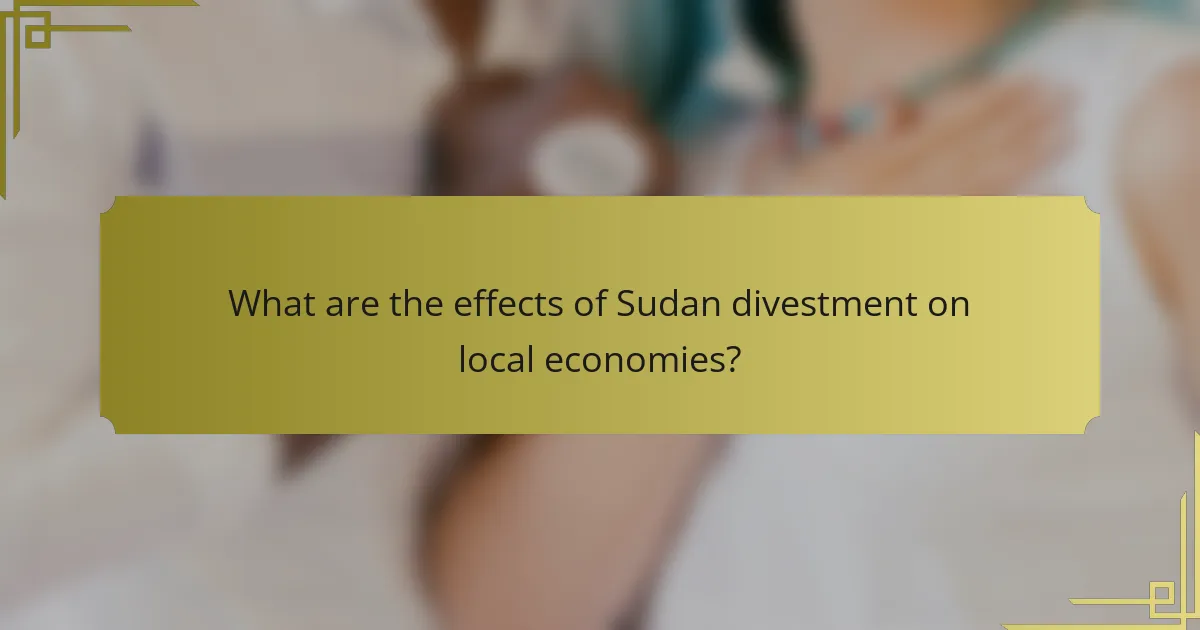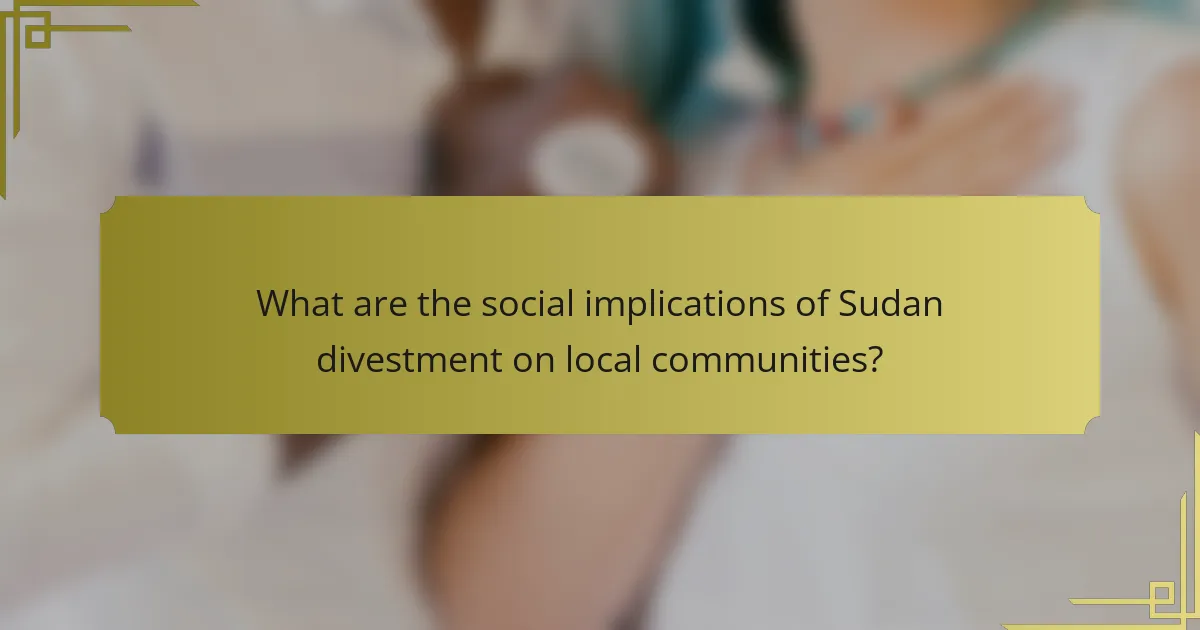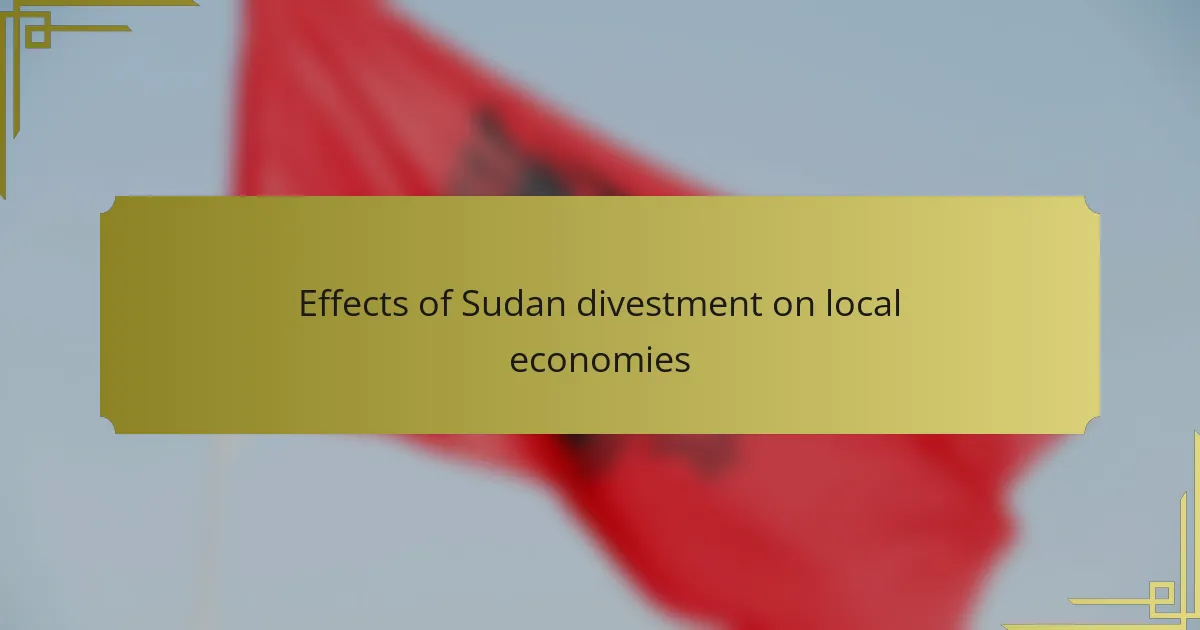Sudan divestment refers to the withdrawal of foreign investments from Sudan, significantly affecting local economies and communities. This divestment leads to reduced funding for local businesses, resulting in job losses, decreased economic activity, and diminished support for essential services such as healthcare and education. Historical data indicates a correlation between divestment and economic downturns, with communities experiencing increased poverty and weakened social cohesion. Potential pathways for recovery include diversifying the economy, investing in alternative sectors, and fostering local entrepreneurship, which can stimulate growth and resilience in the aftermath of divestment.

What are the effects of Sudan divestment on local economies?
Sudan divestment significantly impacts local economies by reducing foreign investment. This withdrawal leads to decreased funding for local businesses. The loss of capital can result in job losses and reduced economic activity. Essential services may suffer due to diminished financial support. Additionally, divestment can lead to increased poverty levels in affected areas. Historical data shows that divestment often correlates with economic downturns. For instance, after the U.S. divested from Sudan in 2008, local businesses reported a sharp decline in revenue. This illustrates the direct relationship between divestment and local economic health.
How does divestment impact economic stability in Sudan?
Divestment negatively impacts economic stability in Sudan. It leads to reduced foreign investment and capital flight. Companies withdrawing from Sudan often take jobs and resources with them. This exacerbates unemployment and poverty levels. Economic sectors reliant on foreign investment suffer significantly. A report from the World Bank indicates that divestment contributes to a decline in GDP. The lack of financial resources hinders public services and infrastructure development. Overall, divestment creates an unstable economic environment that hampers growth.
What are the immediate financial repercussions of divestment?
Divestment leads to immediate financial repercussions such as loss of investment capital and reduced liquidity. Companies divesting from Sudan may face a decline in stock prices due to perceived instability. This can trigger a sell-off by investors concerned about future profitability. Additionally, divestment can result in job losses, as companies withdraw operations and cut local employment. The local economy suffers as businesses that relied on these companies experience reduced revenue. This can lead to decreased public services funded by local taxes. Historical examples show that divestment in similar contexts has led to economic downturns in affected regions.
How does divestment influence long-term economic growth?
Divestment can negatively influence long-term economic growth by reducing investment in critical sectors. When companies divest from regions like Sudan, local economies often suffer from decreased capital inflow. This leads to less funding for infrastructure and public services. Consequently, job creation may slow down, impacting employment rates. Research indicates that divestment can exacerbate poverty levels in affected areas. For instance, a study by the World Bank shows that reduced investment correlates with lower GDP growth in divested regions. Therefore, while divestment aims to address ethical concerns, it can hinder sustainable economic development in the long run.
What sectors are most affected by divestment in Sudan?
The sectors most affected by divestment in Sudan include oil, agriculture, and mining. The oil sector is critical as it represents a significant portion of Sudan’s revenue. Divestment leads to reduced foreign investment and technology transfer in this sector. Agriculture, which employs a large part of the population, suffers from decreased access to markets and investment. This results in lower productivity and food insecurity. The mining sector also faces challenges due to divestment, leading to a decline in mineral extraction and export revenues. These sectors are interconnected, and divestment impacts overall economic stability and growth in Sudan.
Which industries experience the greatest decline due to divestment?
The industries that experience the greatest decline due to divestment are often those heavily reliant on foreign investment and support. In Sudan, these include oil and gas, agriculture, and infrastructure. The divestment from oil and gas leads to reduced production capabilities and job losses. Agriculture suffers from decreased funding and resources, impacting food security. Infrastructure projects face delays and cancellations, hindering economic growth. Historical data shows a significant drop in foreign direct investment in these sectors post-divestment. This decline exacerbates local economic challenges, leading to increased poverty and instability.
How does divestment affect employment rates in key sectors?
Divestment can lead to decreased employment rates in key sectors. When companies withdraw investments, it often results in job losses. This is particularly evident in sectors reliant on foreign investment. For instance, the oil and gas industry may experience significant reductions in workforce. According to a report by the World Bank, divestment can cause up to a 20% decline in employment in affected industries. Additionally, local businesses that depend on these sectors may also suffer, leading to further job losses. Overall, divestment creates a ripple effect that negatively impacts employment across multiple sectors.

What are the social implications of Sudan divestment on local communities?
Sudan divestment has significant social implications for local communities. It can lead to reduced funding for essential services such as healthcare and education. This is primarily due to the withdrawal of foreign investments that support these sectors. Local economies may experience increased unemployment as businesses struggle without external financial support. The loss of income can exacerbate poverty levels within communities. Additionally, social cohesion may be affected as economic instability can lead to increased tensions among community members. Historical examples show that divestment often results in a decline in community resilience. Thus, the social fabric of local communities may weaken as a direct consequence of Sudan divestment.
How does divestment impact community welfare and services?
Divestment negatively impacts community welfare and services by reducing funding for essential programs. When financial resources are withdrawn, local governments may struggle to provide basic services. This can lead to decreased access to healthcare, education, and social services. A study by the World Bank highlighted that divestment in Sudan resulted in a 30% decline in public service funding. Consequently, communities faced increased poverty rates and reduced quality of life. The loss of investment also hampers job creation, further straining local economies. Overall, divestment creates a cycle of decline in community welfare and essential services.
What changes occur in access to essential services post-divestment?
Post-divestment, access to essential services in Sudan typically declines. This decline occurs due to reduced funding and investment in public services. Essential services include healthcare, education, and infrastructure. Without adequate financial support, service providers struggle to maintain operations. Many facilities may close or reduce their hours, leading to longer wait times. The quality of available services often deteriorates as resources become scarce. For instance, healthcare facilities may lack necessary supplies and staff. This situation can exacerbate existing socioeconomic disparities among communities.
How does divestment affect social cohesion within communities?
Divestment can negatively impact social cohesion within communities. When investments are withdrawn, local businesses may suffer from reduced funding. This can lead to job losses and economic instability. As unemployment rises, community members may experience increased stress and tension. Social networks can weaken as people become more isolated due to financial struggles. Studies indicate that economic downturns often correlate with increased crime and social unrest. In Sudan, divestment has contributed to heightened community divisions. The loss of shared economic interests can erode trust among residents. Overall, divestment disrupts the social fabric that binds communities together.
What role do international responses play in local economies post-divestment?
International responses significantly impact local economies post-divestment. These responses can include economic sanctions, foreign aid, and investment shifts. Economic sanctions may restrict trade and investment, leading to reduced economic activity. Conversely, foreign aid can provide essential resources for rebuilding and development. Investment shifts may redirect funds to more stable regions, affecting local job markets. For instance, after the Sudan divestment, international entities altered their investment strategies, impacting local industries. This dynamic interplay shapes the recovery and growth potential of local economies affected by divestment decisions.
How do sanctions and international pressure influence local economic conditions?
Sanctions and international pressure significantly impact local economic conditions by restricting trade and investment. These measures reduce access to foreign markets and financial systems. As a result, local businesses face decreased revenue and higher operational costs. For instance, the U.S. imposed sanctions on Sudan, leading to a sharp decline in oil exports. This caused inflation and a rise in unemployment rates. Furthermore, international pressure can lead to a loss of foreign aid, which is crucial for local development. Overall, sanctions create an environment of economic instability and hardship for the local population.
What support mechanisms are available for affected communities?
Affected communities can access various support mechanisms. These include financial aid programs aimed at rebuilding infrastructure. Non-governmental organizations often provide essential services and resources. Community development initiatives focus on enhancing local economies. Training programs are available to improve job skills and employability. Mental health services address psychological impacts of economic changes. Government assistance programs may offer food security and housing support. International aid can also play a role in providing necessary resources. These mechanisms collectively aim to stabilize and support affected communities during transitions.

What are the potential pathways for economic recovery after divestment?
Potential pathways for economic recovery after divestment include diversification of the economy, investment in alternative sectors, and fostering local entrepreneurship. Diversification reduces reliance on specific industries, making economies more resilient. Investment in sectors such as agriculture, technology, and renewable energy can create new job opportunities. Supporting local entrepreneurship encourages innovation and stimulates economic growth. Additionally, establishing partnerships with international organizations can provide financial aid and technical assistance. Historical examples, such as South Africa’s post-apartheid recovery, show that strategic planning and investment can lead to successful economic revitalization.
How can local economies rebuild after the effects of divestment?
Local economies can rebuild after the effects of divestment by diversifying their economic activities. This involves investing in various sectors such as agriculture, technology, and tourism to reduce reliance on any single industry. Community engagement is crucial in this process. Local stakeholders should be involved in decision-making to ensure that initiatives meet their needs.
Access to capital is essential for rebuilding efforts. Establishing microfinance institutions can provide small businesses with necessary funding. Additionally, partnerships with non-governmental organizations can facilitate skills training and education programs. These initiatives can enhance workforce capabilities, making local economies more resilient.
Government policies should support economic recovery. Implementing tax incentives for new businesses can stimulate investment. Infrastructure development is also vital, as improved transportation and utilities can attract businesses.
Evidence from post-divestment scenarios in other regions shows that these strategies can lead to economic revitalization. For instance, areas that focused on diversification and community involvement often saw quicker recoveries.
What strategies can be implemented to stimulate local businesses?
Implementing strategies to stimulate local businesses can significantly enhance economic activity. One effective strategy is to promote local sourcing, encouraging businesses to purchase from nearby suppliers. This keeps money within the community and supports local jobs. Another strategy is to establish business incubators that provide resources and mentorship for startups. Research shows that incubators can increase business survival rates by up to 87%. Additionally, offering tax incentives for small businesses can lower operational costs. A study from the National Federation of Independent Business found that tax relief leads to job creation. Community events that highlight local businesses can also drive consumer traffic. Engaging local residents through loyalty programs can further increase sales. These strategies collectively contribute to a thriving local economy.
How can international partnerships aid in economic recovery?
International partnerships can significantly aid in economic recovery by facilitating access to resources and markets. These partnerships often lead to increased foreign direct investment, which boosts local economies. For instance, collaboration with international organizations can provide financial assistance and technical expertise. This support helps rebuild infrastructure and create jobs. Additionally, partnerships can enhance trade opportunities, allowing local businesses to reach broader markets. The World Bank reported that countries engaged in international partnerships experienced a 20% faster economic recovery post-crisis. Such collaborations also foster knowledge exchange, leading to improved business practices and innovation.
What best practices can be adopted to mitigate the negative effects of divestment?
Adopting strategic communication is essential to mitigate the negative effects of divestment. Clear messaging can help stakeholders understand the reasons for divestment. Engaging local communities fosters trust and transparency. Providing support for affected workers can alleviate economic impacts. Transition assistance programs can help workers find new employment opportunities. Collaborating with local governments ensures alignment with community needs. Investing in alternative economic initiatives can stimulate local growth. Monitoring and evaluating the outcomes of divestment strategies can inform future actions and adjustments.
What role does community engagement play in recovery efforts?
Community engagement is crucial in recovery efforts as it fosters collaboration and support among affected individuals. Engaging the community enhances trust and transparency in recovery initiatives. It encourages local participation, ensuring that recovery plans address the specific needs and priorities of residents. Studies show that communities actively involved in recovery efforts are more resilient and can recover more effectively. For instance, a report by the United Nations Development Programme highlights that community-led recovery initiatives lead to faster restoration of services and infrastructure. Additionally, community engagement can mobilize resources and volunteers, amplifying the impact of recovery efforts. Overall, community engagement strengthens the social fabric, which is essential for long-term recovery success.
How can lessons learned from past divestments inform future strategies?
Lessons learned from past divestments can guide future strategies by highlighting best practices and potential pitfalls. Historical examples show that divestment can lead to economic shifts, impacting local communities. For instance, the divestment from South Africa during the apartheid era resulted in increased international pressure and eventual policy changes. Analyzing these outcomes helps identify effective engagement strategies. Additionally, understanding the timing and scope of divestments can inform risk management. Evaluating past divestments also reveals the importance of stakeholder communication. This ensures that the concerns of affected communities are addressed. Overall, these lessons can enhance the effectiveness of future divestment strategies.
The main entity of this article is the effects of Sudan divestment on local economies. The article examines how divestment leads to reduced foreign investment, resulting in decreased funding for local businesses, job losses, and increased poverty levels. It highlights the immediate financial repercussions, long-term impacts on economic growth, and the sectors most affected, such as oil, agriculture, and infrastructure. Additionally, the article discusses the social implications, including diminished access to essential services and weakened community cohesion, along with potential pathways for economic recovery and best practices for mitigating negative effects.


